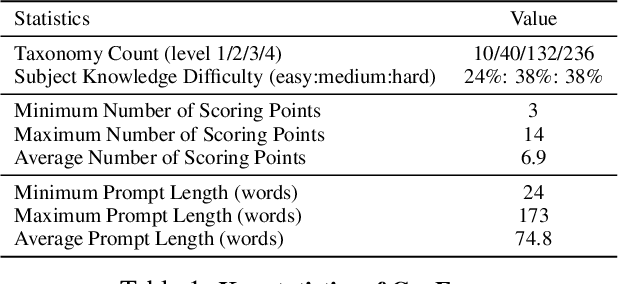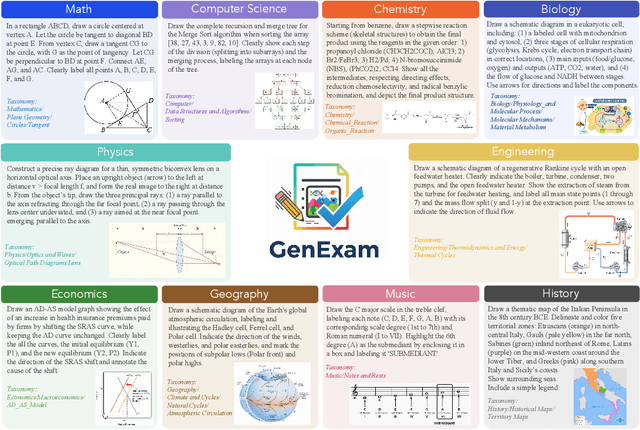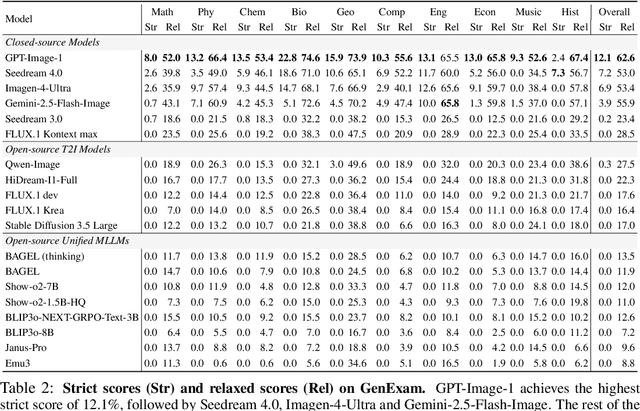Xiangyu Zhao
Victor
TeaRAG: A Token-Efficient Agentic Retrieval-Augmented Generation Framework
Nov 07, 2025Abstract:Retrieval-Augmented Generation (RAG) utilizes external knowledge to augment Large Language Models' (LLMs) reliability. For flexibility, agentic RAG employs autonomous, multi-round retrieval and reasoning to resolve queries. Although recent agentic RAG has improved via reinforcement learning, they often incur substantial token overhead from search and reasoning processes. This trade-off prioritizes accuracy over efficiency. To address this issue, this work proposes TeaRAG, a token-efficient agentic RAG framework capable of compressing both retrieval content and reasoning steps. 1) First, the retrieved content is compressed by augmenting chunk-based semantic retrieval with a graph retrieval using concise triplets. A knowledge association graph is then built from semantic similarity and co-occurrence. Finally, Personalized PageRank is leveraged to highlight key knowledge within this graph, reducing the number of tokens per retrieval. 2) Besides, to reduce reasoning steps, Iterative Process-aware Direct Preference Optimization (IP-DPO) is proposed. Specifically, our reward function evaluates the knowledge sufficiency by a knowledge matching mechanism, while penalizing excessive reasoning steps. This design can produce high-quality preference-pair datasets, supporting iterative DPO to improve reasoning conciseness. Across six datasets, TeaRAG improves the average Exact Match by 4% and 2% while reducing output tokens by 61% and 59% on Llama3-8B-Instruct and Qwen2.5-14B-Instruct, respectively. Code is available at https://github.com/Applied-Machine-Learning-Lab/TeaRAG.
AdaSwitch: Adaptive Switching Generation for Knowledge Distillation
Oct 09, 2025Abstract:Small language models (SLMs) are crucial for applications with strict latency and computational constraints, yet achieving high performance remains challenging. Knowledge distillation (KD) can transfer capabilities from large teacher models, but existing methods involve trade-offs: off-policy distillation provides high-quality supervision but introduces a training-inference mismatch, while on-policy approaches maintain consistency but rely on low-quality student outputs. To address these issues, we propose AdaSwitch, a novel approach that dynamically combines on-policy and off-policy generation at the token level. AdaSwitch allows the student to first explore its own predictions and then selectively integrate teacher guidance based on real-time quality assessment. This approach simultaneously preserves consistency and maintains supervision quality. Experiments on three datasets with two teacher-student LLM pairs demonstrate that AdaSwitch consistently improves accuracy, offering a practical and effective method for distilling SLMs with acceptable additional overhead.
Causality-aware Graph Aggregation Weight Estimator for Popularity Debiasing in Top-K Recommendation
Oct 06, 2025Abstract:Graph-based recommender systems leverage neighborhood aggregation to generate node representations, which is highly sensitive to popularity bias, resulting in an echo effect during information propagation. Existing graph-based debiasing solutions refine the aggregation process with attempts such as edge reconstruction or weight adjustment. However, these methods remain inadequate in fully alleviating popularity bias. Specifically, this is because 1) they provide no insights into graph aggregation rationality, thus lacking an optimality guarantee; 2) they fail to well balance the training and debiasing process, which undermines the effectiveness. In this paper, we propose a novel approach to mitigate popularity bias through rational modeling of the graph aggregation process. We reveal that graph aggregation is a special form of backdoor adjustment in causal inference, where the aggregation weight corresponds to the historical interaction likelihood distribution. Based on this insight, we devise an encoder-decoder architecture, namely Causality-aware Graph Aggregation Weight Estimator for Debiasing (CAGED), to approximate the unbiased aggregation weight by optimizing the evidence lower bound of the interaction likelihood. In order to enhance the debiasing effectiveness during early training stages, we further design a momentum update strategy that incrementally refines the aggregation weight matrix. Extensive experiments on three datasets demonstrate that CAGED outperforms existing graph-based debiasing methods. Our implementation is available at https://github.com/QueYork/CAGED.
Empowering Denoising Sequential Recommendation with Large Language Model Embeddings
Oct 05, 2025Abstract:Sequential recommendation aims to capture user preferences by modeling sequential patterns in user-item interactions. However, these models are often influenced by noise such as accidental interactions, leading to suboptimal performance. Therefore, to reduce the effect of noise, some works propose explicitly identifying and removing noisy items. However, we find that simply relying on collaborative information may result in an over-denoising problem, especially for cold items. To overcome these limitations, we propose a novel framework: Interest Alignment for Denoising Sequential Recommendation (IADSR) which integrates both collaborative and semantic information. Specifically, IADSR is comprised of two stages: in the first stage, we obtain the collaborative and semantic embeddings of each item from a traditional sequential recommendation model and an LLM, respectively. In the second stage, we align the collaborative and semantic embeddings and then identify noise in the interaction sequence based on long-term and short-term interests captured in the collaborative and semantic modalities. Our extensive experiments on four public datasets validate the effectiveness of the proposed framework and its compatibility with different sequential recommendation systems.
GenExam: A Multidisciplinary Text-to-Image Exam
Sep 17, 2025



Abstract:Exams are a fundamental test of expert-level intelligence and require integrated understanding, reasoning, and generation. Existing exam-style benchmarks mainly focus on understanding and reasoning tasks, and current generation benchmarks emphasize the illustration of world knowledge and visual concepts, neglecting the evaluation of rigorous drawing exams. We introduce GenExam, the first benchmark for multidisciplinary text-to-image exams, featuring 1,000 samples across 10 subjects with exam-style prompts organized under a four-level taxonomy. Each problem is equipped with ground-truth images and fine-grained scoring points to enable a precise evaluation of semantic correctness and visual plausibility. Experiments show that even state-of-the-art models such as GPT-Image-1 and Gemini-2.5-Flash-Image achieve less than 15% strict scores, and most models yield almost 0%, suggesting the great challenge of our benchmark. By framing image generation as an exam, GenExam offers a rigorous assessment of models' ability to integrate knowledge, reasoning, and generation, providing insights on the path to general AGI.
GLEAM: Learning to Match and Explain in Cross-View Geo-Localization
Sep 09, 2025Abstract:Cross-View Geo-Localization (CVGL) focuses on identifying correspondences between images captured from distinct perspectives of the same geographical location. However, existing CVGL approaches are typically restricted to a single view or modality, and their direct visual matching strategy lacks interpretability: they merely predict whether two images correspond, without explaining the rationale behind the match. In this paper, we present GLEAM-C, a foundational CVGL model that unifies multiple views and modalities-including UAV imagery, street maps, panoramic views, and ground photographs-by aligning them exclusively with satellite imagery. Our framework enhances training efficiency through optimized implementation while achieving accuracy comparable to prior modality-specific CVGL models through a two-phase training strategy. Moreover, to address the lack of interpretability in traditional CVGL methods, we leverage the reasoning capabilities of multimodal large language models (MLLMs) to propose a new task, GLEAM-X, which combines cross-view correspondence prediction with explainable reasoning. To support this task, we construct a bilingual benchmark using GPT-4o and Doubao-1.5-Thinking-Vision-Pro to generate training and testing data. The test set is further refined through detailed human revision, enabling systematic evaluation of explainable cross-view reasoning and advancing transparency and scalability in geo-localization. Together, GLEAM-C and GLEAM-X form a comprehensive CVGL pipeline that integrates multi-modal, multi-view alignment with interpretable correspondence analysis, unifying accurate cross-view matching with explainable reasoning and advancing Geo-Localization by enabling models to better Explain And Match. Code and datasets used in this work will be made publicly accessible at https://github.com/Lucky-Lance/GLEAM.
Dual Knowledge-Enhanced Two-Stage Reasoner for Multimodal Dialog Systems
Sep 09, 2025



Abstract:Textual response generation is pivotal for multimodal \mbox{task-oriented} dialog systems, which aims to generate proper textual responses based on the multimodal context. While existing efforts have demonstrated remarkable progress, there still exist the following limitations: 1) \textit{neglect of unstructured review knowledge} and 2) \textit{underutilization of large language models (LLMs)}. Inspired by this, we aim to fully utilize dual knowledge (\textit{i.e., } structured attribute and unstructured review knowledge) with LLMs to promote textual response generation in multimodal task-oriented dialog systems. However, this task is non-trivial due to two key challenges: 1) \textit{dynamic knowledge type selection} and 2) \textit{intention-response decoupling}. To address these challenges, we propose a novel dual knowledge-enhanced two-stage reasoner by adapting LLMs for multimodal dialog systems (named DK2R). To be specific, DK2R first extracts both structured attribute and unstructured review knowledge from external knowledge base given the dialog context. Thereafter, DK2R uses an LLM to evaluate each knowledge type's utility by analyzing LLM-generated provisional probe responses. Moreover, DK2R separately summarizes the intention-oriented key clues via dedicated reasoning, which are further used as auxiliary signals to enhance LLM-based textual response generation. Extensive experiments conducted on a public dataset verify the superiority of DK2R. We have released the codes and parameters.
GeoArena: An Open Platform for Benchmarking Large Vision-language Models on WorldWide Image Geolocalization
Sep 04, 2025



Abstract:Image geolocalization aims to predict the geographic location of images captured anywhere on Earth, but its global nature presents significant challenges. Current evaluation methodologies suffer from two major limitations. First, data leakage: advanced approaches often rely on large vision-language models (LVLMs) to predict image locations, yet these models are frequently pretrained on the test datasets, compromising the accuracy of evaluating a model's actual geolocalization capability. Second, existing metrics primarily rely on exact geographic coordinates to assess predictions, which not only neglects the reasoning process but also raises privacy concerns when user-level location data is required. To address these issues, we propose GeoArena, a first open platform for evaluating LVLMs on worldwide image geolocalization tasks, offering true in-the-wild and human-centered benchmarking. GeoArena enables users to upload in-the-wild images for a more diverse evaluation corpus, and it leverages pairwise human judgments to determine which model output better aligns with human expectations. Our platform has been deployed online for two months, during which we collected over thousands voting records. Based on this data, we conduct a detailed analysis and establish a leaderboard of different LVLMs on the image geolocalization task.
Generative Auto-Bidding in Large-Scale Competitive Auctions via Diffusion Completer-Aligner
Sep 03, 2025Abstract:Auto-bidding is central to computational advertising, achieving notable commercial success by optimizing advertisers' bids within economic constraints. Recently, large generative models show potential to revolutionize auto-bidding by generating bids that could flexibly adapt to complex, competitive environments. Among them, diffusers stand out for their ability to address sparse-reward challenges by focusing on trajectory-level accumulated rewards, as well as their explainable capability, i.e., planning a future trajectory of states and executing bids accordingly. However, diffusers struggle with generation uncertainty, particularly regarding dynamic legitimacy between adjacent states, which can lead to poor bids and further cause significant loss of ad impression opportunities when competing with other advertisers in a highly competitive auction environment. To address it, we propose a Causal auto-Bidding method based on a Diffusion completer-aligner framework, termed CBD. Firstly, we augment the diffusion training process with an extra random variable t, where the model observes t-length historical sequences with the goal of completing the remaining sequence, thereby enhancing the generated sequences' dynamic legitimacy. Then, we employ a trajectory-level return model to refine the generated trajectories, aligning more closely with advertisers' objectives. Experimental results across diverse settings demonstrate that our approach not only achieves superior performance on large-scale auto-bidding benchmarks, such as a 29.9% improvement in conversion value in the challenging sparse-reward auction setting, but also delivers significant improvements on the Kuaishou online advertising platform, including a 2.0% increase in target cost.
A Survey of Scientific Large Language Models: From Data Foundations to Agent Frontiers
Aug 28, 2025



Abstract:Scientific Large Language Models (Sci-LLMs) are transforming how knowledge is represented, integrated, and applied in scientific research, yet their progress is shaped by the complex nature of scientific data. This survey presents a comprehensive, data-centric synthesis that reframes the development of Sci-LLMs as a co-evolution between models and their underlying data substrate. We formulate a unified taxonomy of scientific data and a hierarchical model of scientific knowledge, emphasizing the multimodal, cross-scale, and domain-specific challenges that differentiate scientific corpora from general natural language processing datasets. We systematically review recent Sci-LLMs, from general-purpose foundations to specialized models across diverse scientific disciplines, alongside an extensive analysis of over 270 pre-/post-training datasets, showing why Sci-LLMs pose distinct demands -- heterogeneous, multi-scale, uncertainty-laden corpora that require representations preserving domain invariance and enabling cross-modal reasoning. On evaluation, we examine over 190 benchmark datasets and trace a shift from static exams toward process- and discovery-oriented assessments with advanced evaluation protocols. These data-centric analyses highlight persistent issues in scientific data development and discuss emerging solutions involving semi-automated annotation pipelines and expert validation. Finally, we outline a paradigm shift toward closed-loop systems where autonomous agents based on Sci-LLMs actively experiment, validate, and contribute to a living, evolving knowledge base. Collectively, this work provides a roadmap for building trustworthy, continually evolving artificial intelligence (AI) systems that function as a true partner in accelerating scientific discovery.
 Add to Chrome
Add to Chrome Add to Firefox
Add to Firefox Add to Edge
Add to Edge